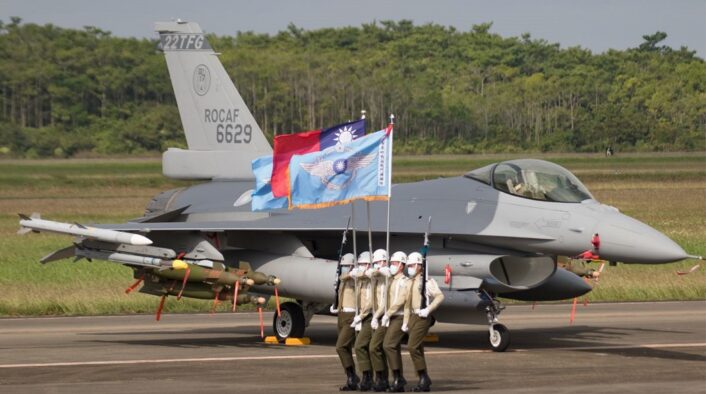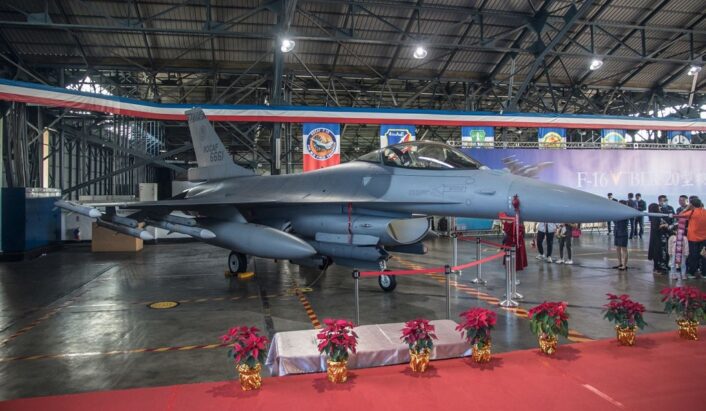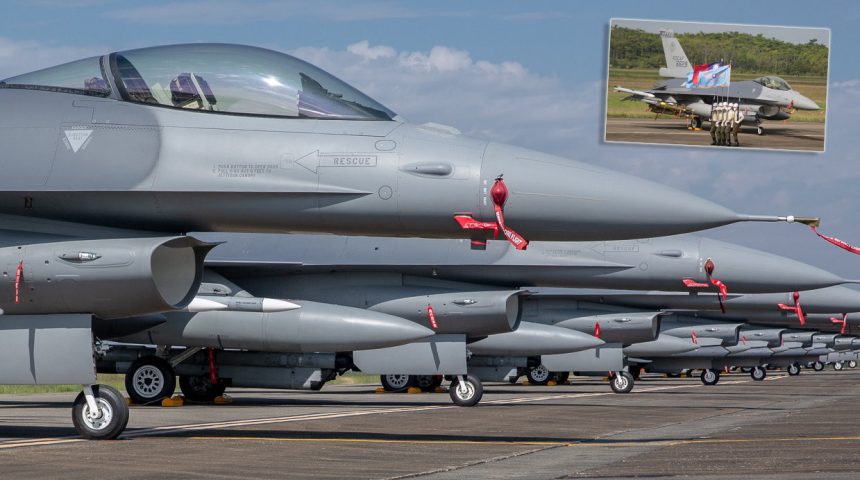Taiwan becomes the first operator to field operationally the F-16V, the upgraded variant of the “Viper”.
On November 18, 2021 Taiwan has become the first operator to achieve the Full Operational Capability with the upgraded F-16V Block 72. The milestone was celebrated with the official induction into service of the aircraft in the 4th Tactical Fighter Wing of the Republic of China Air Force at Chiayi Air Base, at the presence of the Taiwanese President Tsai Ing Wen.
“These aircraft symbolize our close cooperation with the US and are equipped with advanced technology that will substantially strengthen our national defense”, said the President. In the photos published by the Associated Press, the President is seen inspecting the aircraft on the flight line, as well as taking photos in the front seat of two-seater F-16 accompanied by a pilot.
#Taiwan‘s first squadron of upgraded F-16V fighter jets has entered service. These aircraft symbolize our close cooperation with the US & are equipped with advanced technology that will substantially strengthen our national defense. pic.twitter.com/S2QV9pSkWN
— 蔡英文 Tsai Ing-wen (@iingwen) November 18, 2021
The F-16s on exhibit were configured with live weapons loadout for different types of mission. One of the aircraft was loaded for maritime missions with two AGM-84 Harpoon anti-ship missiles, two AIM-120C-7 AMRAAM and two AIM-9X Sidewinder (these two were inert, as shown by the blue stripes) air-to-air missiles, two 370 gal external fuel tanks and an ALQ-184 ECM pod. Taiwanese F-16s are among the few with the Harpoon capability, which was recently showed off in an attempt to deter activities of the People’s Liberation Army Navy (PLAN) in the Taiwan Strait.
🇹🇼 EARLIER: Taiwanese President Tsai Ing-Wen leads a commissioning ceremony of Taiwan’s first F-16V (Viper) combat wing at the Air Force’s Chiayi Base pic.twitter.com/B9V9G9Or2E
— Bloomberg Quicktake (@Quicktake) November 18, 2021
Another configuration visible in the images taken at the presentation of the F-16V was dedicated to pure Beyond Visual Range air-to-air missions, with the Viper showing a full load of six AIM-120C-7 AMRAAM air-to-air missiles, in addition to the two 370 gal external fuel tanks and ALQ-184 ECM pod, the AAQ-33 Sniper Advanced Targeting Pod (ATP) and another previously unseen interesting pod on the other chin hardpoint. This pod, while not clearly visible, is almost externally identical to the FLIR (Forward Looking InfraRed) section of the AAQ-13 LANTIRN (Low Altitude Navigation and Targeting Infrared for Night) pod, with the Terrain Following Radar (TFR) removed.
ROCAF F-16AM (F-16V) on static display with three live AIM-120s on each wing at the FOC declaration ceremony today at Chiayi. Funnily there is a QR code stenciled on this AMRAAM contracted in 2008. (Credit: Wayne Hsu Facebook) pic.twitter.com/46xmgpUqio
— Roy Choo (@RXRoy) November 18, 2021
The last configuration visible in the photos was dedicated to air to ground missions, with two AIM-120C-7 AMRAAM and two AIM-9X Sidewinder (again inert) air-to-air missiles, two 370 gal external fuel tanks, ALQ-184 ECM pod, AAQ-33 Sniper ATP and, interestingly, Triple Ejector Racks (TER) with three GBU-12 Paveway II laser-guided bombs each. Even if the TER is rated for three weapons, when it comes to Paveway bombs it is usually seen loaded with just two bombs, as the third one would reportedly have clearance issues between its tail fins (once they open when the weapon is released) and the external fuel tanks.

The Taiwanese F-16s have a wide array of weapons at their disposal, with all the weapons that we just listed, as well as some others that were not shown but were already in the inventory, as the AGM-65 Maverick air-to-ground guided missile, AIM-9L Sidewinder air-to-air missiles, Mk-82 and Mk-84 “dumb” bombs, GBU-10 Paveway II laser-guided bombs. In addition to these, AGM-154 Joint Stand-Off Weapon (JSOW) and Standoff Land Attack Missile Expanded Response (SLAM-ER) sales were later approved by the USA.

Taiwan signed a contract to upgrade the fleet of F-16A/B Block 20 fighter jets in 2012, with the program dubbed “Peace Phoenix Rising”. Initially, it was decided to upgrade 144 Vipers (as the F-16 is dubbed by the pilots), but three of those were later lost in mishaps and thus the final number of jets to be upgraded is 141, of which 64 have already completed the upgrade process and have been handed over to the RoCAF. It is not known if all 64 aircraft are currently based at Chiayi, but it is expected that the 5th TFW at Hualien Air Base, another F-16 Block 20 base, will receive the upgraded F-16V too.
Among the new systems installed during the upgrade we can find the APG-83 AESA (Active Electronically Scanned Array) radar, a new Center Pedestal Display (CPD), Link 16 datalink, full NVIS (Night Vision Imaging System) and JHCMS II (Joint Helmet-Mounted Cueing System II) compatibility, a new Embedded GPS/INS (EGI), a modern commercial off-the-shelf (COTS)-based avionics subsystem, a high-volume, high-speed data bus.
The first jet was upgraded as a prototype by Lockheed Martin at their facilities in Fort Worth (Texas) and flew for the first time in 2015, with Taiwan’s Aerospace Industrial Development Corporation (AIDC) taking over a year later the works to upgrade the F-16 locally. The work started slowly, with the first four F-16Vs delivered only in 2018, but then proceeded at a rhythm of at least 24 aircraft per year once all problems were solved. The retrofit of the whole fleet is planned to be completed by 2023.
In the meanwhile, Taiwan also acquired in 2019 66 newly built F-16V Block 70 that are expected to be delivered from 2023 to 2026. The new aircraft will reportedly be assigned to the 7th TFW at Taitung Air Base. Earlier this year, the “Peace Phoenix Rising 2” was announced, with the intent of fielding new capabilities for the Automatic Ground Collision Avoidance System (AGCAS), AGM-88 HARM (High Speed Anti-radiation Missile), radar software improvements and an Advanced Identification Friend or Foe in addition to the already planned upgrades.









